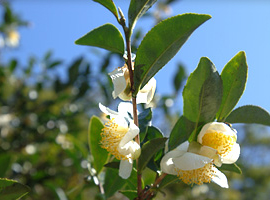Characteristics of Tea Tree
Academic Name
Geographical location of Hadong Camellia-Sinensis (L) 0, Kuntze (Camellia / Cine-cines (Linne) / Oh,
Silhwasangbongsu(Real meeting with flowers, 實花相逢樹)
The tea tree is a short perennial evergreen tree with think, shiny and long oval leaves of a length of 3-4cm.

The tea is a sub-tropical evergreen plant, which is widely distributed from tropical to temperate regions. The production limit temperature is12 to 13 ℃ per year and preferable annual precipitation is 1,300 mm or more. The specie prefers mildly acidic soil is preferred and is native to the area. Our Hadong tea tree is of Chinese small leaf species and grows on jade-like dew, giving out with green and fresh vigor.
What is Silhwasangbongsu(Real meeting with flowers, 實花相逢樹)?
When the plants bloom, seeds and fruit ripen in the same year. However, tea tree is ecologically unique that when it blooms (September ~ October), it ripens after a year. It meets flowers that bloom one year after the ripening of fruit. It is read Silhwasangbongsu in Chinese. It is also called as the tree of harmony as the fruit which was flower a year ago encountering flower a year after resembles ancestors welcoming descendants.
Leaf
The leaf is thick and hard and the surface is glossy green. The leaf stalk is short and there are 30 small saw teeth on the leaves.
Flower
1~3 flowers bloom between the leaves of branches and the end of the trunk. And there are 180~240 stamens in one flower and there are 5 sepals.
Flowers start to form in June and bloom until the late September ~ late October. Although buds are formed after that, they cannot bloom.
Fertilization and Fruition
The ovary has 2 ~ 4 pieces, and fertilization status can be confirmed after 13 days after pollination. Unfertilized flowers stop growing. The fertilized fruit barely grows in winter but starts to develop from spring. It grows enough in summer and matures from mid-October to mid-November.
The fruition rate is about 40 ~ 60% in case of crossbreeding and about 2-3% for self - fertilization.
Root
As tap-rooted species, main roots are stretched to 2m below the ground. Lateral roots stem from the main roots, stemming numerous tertiary roots in 15~18㎝ below the ground. Taproots of seedling roots are stretched deeply whereas rooted cutting stretches lightly.

